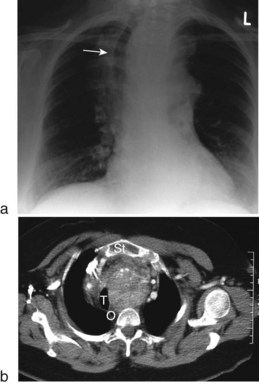11 Endocrine surgery
Most surgical endocrine disorders are neoplastic, autoimmune or genetic. These conditions may or may not result in endocrine dysfunction depending on whether there is abnormal hormone secretion. The principles of endocrine surgery have been crystallised by John Lynn and are summarised in Table 11.1.
Table 11.1 Principles of endocrine surgery
| Principle | Example |
|---|---|
| Be convinced of the biochemical diagnosis | In Cushing’s syndrome, is the primary problem of pituitary or adrenal origin? |
| Make the patient safe | Control thyrotoxicosis in Graves’ disease, or hypertension in phaeochromocytoma |
| Localise the tumour(s) | In Conn’s syndrome, which side is the adenoma? CT and renal vein sampling may be necessary |
| Is an operation necessary? | Sometimes medical therapy is more effective, e.g. radioiodine for hyperthyroidism |
| Decide best technique | Open versus laparoscopic adrenalectomy |
The thyroid
Surgical anatomy
The thyroid is fixed to the trachea by the pretracheal fascia so it moves up on swallowing. Aberrant thyroid tissues may be found anywhere along the embryological descent of the gland. Blood supply is from the superior and inferior thyroid arteries. Thyroid operations may damage important structures, highlighted in Table 11.2.
| Structure | Result of injury |
|---|---|
| Recurrent laryngeal nerve | Paresis or paralysis of vocal cord: unilateral – hoarseness bilateral – stridor; change in voice; risk of aspiration |
| Parathyroid glands | Hypocalcaemia – severity depends on amount of tissue that remains |
| External laryngeal nerve | Paresis or paralysis of cricothyroid muscle – inability to achieve high-pitched notes |
Goitre
Investigation
The aims of investigation are twofold:
• determine thyroid function (serum thyroid-stimulating hormone (TSH) and T3/T4)
• exclude malignancy (by thyroid ultrasound and fine-needle aspiration cytology (FNAC)).
CXR ± CT may be useful to determine extent of larger goitres extending into the chest (Fig. 11.1).
Thyrotoxicosis
This is a common problem affecting 2% of females and 0.15% of males. The three main causes are:
Graves’ disease
This is the commonest cause of thyrotoxicosis, usually occurring between the ages of 20 and 40 years. Women are affected five times more often than males. Graves’ disease is due to an autoimmune process characterised by abnormal autoantibodies directed against thyroid TSH receptors. The natural history of Graves’ disease is one of intermittent remission and relapse. The thyroid is uniformly enlarged, firm and smooth, not nodular. Eye problems are common (Table 11.3). Thyroid function tests confirm an elevated T3 and T4 and reduced TSH. Anti-thyroglobulin and anti-microsomal antibodies are present when the cause is autoimmune.
| Symptoms | Signs |
|---|---|
| Poor sight for both near and distant objects | Ophthalmoplegia |
| Double vision | |
| Grittiness in the eye | Conjunctival oedema (chemosis) |
| Exophthalmos – protrusion of the globes | Exophthalmos |
| Lid retraction | |
| Lid lag |
Management of thyrotoxicosis
Treat eye complications (seek ophthalmology opinion); see Table 11.4.
Table 11.4 Management of eye complications in Graves’ disease
| Problem | Treatment |
|---|---|
| Exposed cornea with drying | Methylcellulose eye drops for lubrication |
| Failure of lid closure in marked exophthalmos | Tarsorrhaphy |
| Inflammation | Systemic steroids |
| Deterioration in sight from compressive optic atrophy | Surgical decompression of both orbits |
| Severe diplopia | Corrective surgery to eye muscles |








